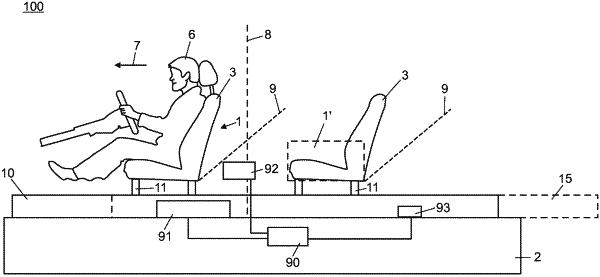| CPC B60N 2/02246 (2023.08) [B60N 2/0705 (2013.01); B60N 2/4214 (2013.01); B60N 2/4279 (2013.01); B60N 2/42709 (2013.01); B60N 2/02 (2013.01); B60N 2/42781 (2013.01)] | 22 Claims |

|
1. A seat rail module for a vehicle seat, comprising:
two rails for longitudinal adjustment arranged parallel to one another for guidance and longitudinal adjustment of the vehicle seat, each rail for longitudinal adjustment having a lower rail, which can be fixedly fastened to a floor of a vehicle body, and an upper rail, which can be displaced longitudinally with respect to the lower rail,
a drive member having a drive coupled to the drive member, for longitudinal adjustment of the vehicle seat,
at least one deformation member coupled to an associated rail for longitudinal adjustment, and
at least one fastening member for fastening the drive member to the associated lower rail or upper rail, wherein
the upper rails are designed so that the vehicle seat can be fastened to the upper rails, and
the deformation member is designed to be deformed upon displacement of the vehicle seat in a main direction of travel to dissipate energy in the event of a crash and to decelerate the vehicle seat;
said seat rail module further comprising an actuator for locking and unlocking the at least one fastening member, wherein
in a locked position of the fastening member, the drive member is secured by the fastening member directly to the associated lower rail or upper rail, and
the fastening member is mechanically unlocked upon displacement of the vehicle seat beyond a predetermined limit setting, so that the drive member is coupled to the associated lower rail or upper rail via the deformation member.
|